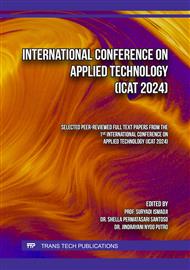[1]
Goenawan, Stephanus Ivan. (2020). Comparison Simulation Analysis Of The Gradual Summation Of A Function With Recognition Of Direct Extrapolation Via In Series. IJASST Univ. Sanata Dharma, Yogyakarta.
Google Scholar
[2]
Goenawan, Stephanus Ivan. (2020). Metode Pengukuran Sensor Non-Linier Dengan Persamaan Konstanta Goen. Patent No. P00202007763.
Google Scholar
[3]
Karl Hinrichs. (2010) "System For Linearizing A Non-Linear Sensor Output". Patent US5274577A.
Google Scholar
[4]
T·蒂耶克P·T·J·根尼森. (2009). Arrangement for linearizing non-linear sensor. 2009 Paten CN102099662B
Google Scholar
[5]
Ekelof, Stig. (February 2010). "The Genesis of the Wheatstone Bridge". Engineering Science and Education Journal. 10 (1): 37–40.
Google Scholar
[6]
Jihong Yan (2015). Machinery Prognostics and Prognosis Oriented Maintenance Management. 2015 Wiley & Sons Singapore Pte. Ltd. p.107. ISBN 9781118638729.
DOI: 10.1002/9781118638743
Google Scholar
[7]
Ganesh Kumar, Modern General Knowledge. 2010 Upkar Prakashan. p.194. ISBN 978-81-7482-180-5.
Google Scholar
[8]
C. A. Grimes, E. C. Dickey, and M. V. Pishko, Encyclopedia of Sensors, 2006 American Scientific Publishers. ISBN 1-58883-056-X
Google Scholar
[9]
Bǎnicǎ, Florinel-Gabriel. Chemical Sensors and Biosensors:Fundamentals and Applications. 2012 Chichester, UK: John Wiley & Sons. p.576. ISBN 978-1-118-35423-0.
Google Scholar
[10]
Johnson, Kevin J.; Rose-Pehrsson, Susan L. "Sensor Array Design for Complex Sensing Tasks". 2015 Annual Review of Analytical Chemistry. 8 (1): 287–310. Bibcode: 2015ARAC....8..287J. doi:10.1146/annurev-anchem-062011-143205. ISSN 1936-1327. PMID 26132346.
DOI: 10.1146/annurev-anchem-062011-143205
Google Scholar
[11]
Li, Zheng; Askim, Jon R.; Suslick, Kenneth S. "The Optoelectronic Nose: Colorimetric and Fluorometric Sensor Arrays". 2019 Chemical Reviews. 119 (1): 231–292. doi:10.1021/acs.chemrev.8b00226. ISSN 0009-2665. PMID 30207700. S2CID 206542436.
DOI: 10.1021/acs.chemrev.8b00226
Google Scholar
[12]
Askim, Jon R.; Mahmoudi, Morteza; Suslick, Kenneth S. "Optical sensor arrays for chemical sensing: the optoelectronic nose". 2013 Chemical Society Reviews. 42 (22): 8649–8682. doi:10.1039/C3CS60179J. ISSN 1460-4744. PMID 24091381.
DOI: 10.1039/c3cs60179j
Google Scholar
[13]
Vanarse, Anup; Osseiran, Adam; Rassau, Alexander. "A Review of Current Neuromorphic Approaches for Vision, Auditory, and Olfactory Sensors". 2016 Frontiers in Neuroscience. 10: 115. doi:10.3389/fnins.2016.00115. PMC 4809886. PMID 27065784.
DOI: 10.3389/fnins.2016.00115
Google Scholar
[14]
Chris Toumazou; Pantelis Georgiou. "40 years of ISFET technology: From neuronal sensing to DNA sequencing". 2011 Electronics Letters. Retrieved 13 May 2016.
DOI: 10.1049/el.2011.3231
Google Scholar
[15]
Williams, J. B. The Electronics Revolution: Inventing the Future. 2017 Springer. p.245 & 249. ISBN 9783319490885.
Google Scholar
[16]
Young, H.D.; Freedman, R.A. (2014). Sears and Zemansky's University Physics with Modern Physics Technology Update (13th ed.). Pearson Education. ISBN 978-1-292-02063-1.
Google Scholar
[17]
Rosenberg, Alex (2006). Philosophy of Science. Routledge. ISBN 978-0-415-34317-6.
Google Scholar
[18]
Ashby, Michael; Shercliff, Hugh; Cebon, David. (2010). Materials engineering, science, processing and design (2nd ed.). Oxford: Elsevier. ISBN 9781856178952.
DOI: 10.1080/10426910701624012
Google Scholar
[19]
Lyon, Richard F. "The Optical Mouse: Early Biomimetic Embedded Vision". 2014 Advances in Embedded Computer Vision. Springer. p.3–22 (3). ISBN 9783319093871.
DOI: 10.1007/978-3-319-09387-1_1
Google Scholar
[20]
Brain, Marshall; Carmack, Carmen. "How Computer Mice Work". 2000 HowStuffWorks.
Google Scholar
[21]
Omura, Yasuhisa; Mallik, Abhijit; Matsuo, Naoto. MOS Devices for Low-Voltage and Low-Energy Applications. 2017 John Wiley & Sons. p.3–4. ISBN 9781119107354.
DOI: 10.1002/9781119107361
Google Scholar
[22]
M. Kretschmar and S. Welsby. Capacitive and Inductive Displacement Sensors, 2005 in Sensor Technology Handbook, J. Wilson editor, Newnes: Burlington, MA.
DOI: 10.1016/b978-075067729-5/50048-3
Google Scholar
[23]
Oliveira, Joao; Goes, João. Parametric Analog Signal Amplification Applied to Nanoscale CMOS Technologies. 2012 Springer Science & Business Media. p.7. ISBN 9781461416708.
DOI: 10.1007/978-1-4614-1671-5
Google Scholar
[24]
Blaauw, F.J., Schenk, H.M., Jeronimus, B.F., van der Krieke, L., de Jonge, P., Aiello, M., Emerencia, A.C. Let's get Physiqual – An intuitive and generic method to combine sensor technology with ecological momentary assessments. 2016 Journal of Biomedical Informatics, vol. 63, page 141–149.
DOI: 10.1016/j.jbi.2016.08.001
Google Scholar


